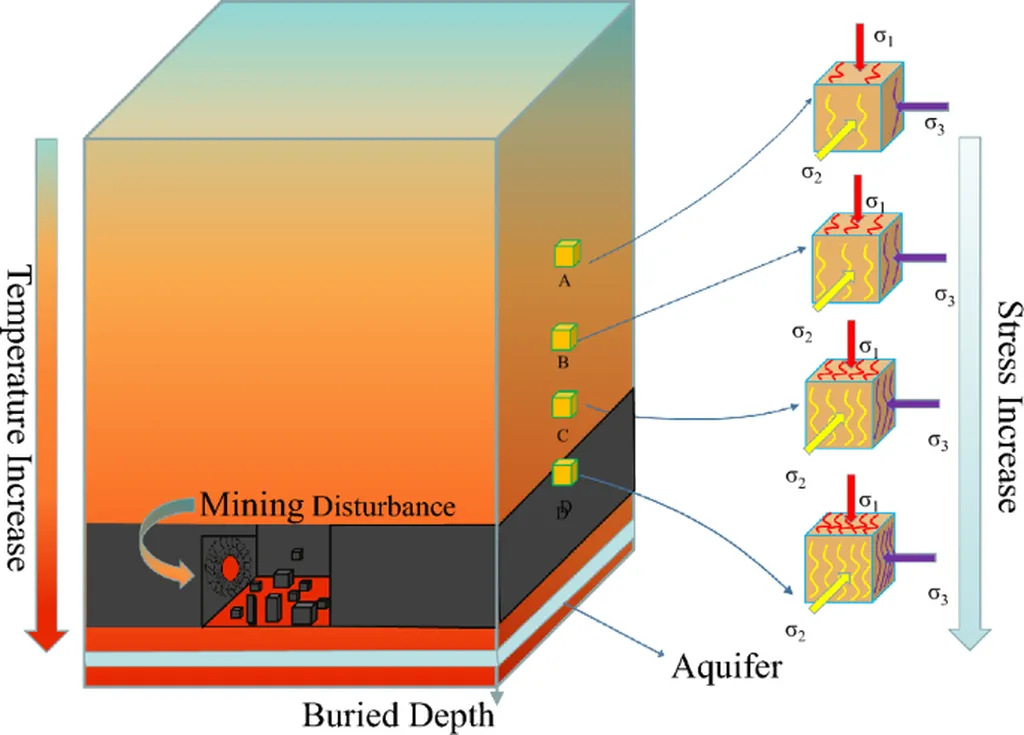In the heart of China’s burgeoning energy sector, a groundbreaking study led by Mingyuan Lu from the China University of Mining and Technology-Beijing is revolutionizing our understanding of deep underground rock mechanics. Published in the esteemed journal *Meitan xuebao* (translated to *Coal Science and Technology*), Lu’s research delves into the intricate behaviors of rocks under the extreme conditions found in deep underground environments, offering promising insights for the mining, oil, gas, and geothermal industries.
As China’s demand for underground resources continues to grow, so does the need to venture deeper into the Earth’s crust. However, the extreme conditions at these depths—high stress, high pore pressure, and high temperatures—pose significant challenges. Conventional rock mechanical experiments often fall short of replicating these in-situ conditions, leading to a gap in understanding the true mechanical behavior of deep rocks.
Lu’s research introduces the concept of deep in-situ multi-physics conditions, aiming to bridge this gap. By reconstructing the stress, pore pressure, and temperature conditions found at depths ranging from 1,000 to 6,400 meters in the Songliao Basin, Lu and his team have conducted a series of experiments that shed light on the intrinsic mechanical behavior of deep rocks.
One of the key findings is that applying time-dependent stress boundaries equivalent to in-situ conditions can effectively suppress stress release effects in deep cores. This process promotes microcrack closure and intergranular contact, enhancing the structural compactness and load-bearing capacity of the rocks. “Under in-situ stress-reconstructed experiments, we observed a significant increase in the elastic modulus and peak deviatoric stress, approximately 10% higher than in conventional triaxial experiments,” Lu explains. This enhanced understanding of rock behavior under in-situ stress conditions can lead to more accurate predictions of rock stability and failure, crucial for the safety and efficiency of deep underground operations.
The study also explores the impact of in-situ pore pressure on rock mechanics. The introduction of non-uniform pore pressure generally leads to a reduction in mechanical strength, an effect that diminishes with increasing depth. “In-situ pore pressure exerts a weakening influence on rock strength, but its magnitude is constrained by the confining stress,” Lu notes. This insight is particularly relevant for the oil and gas industry, where understanding the interplay between pore pressure and rock strength can enhance drilling and extraction processes.
Furthermore, the research investigates the thermal response of porous media under variable temperature conditions. Using nuclear magnetic resonance (NMR) experiments on coal samples from the Zhaolou Coal Mine in Shandong Province, Lu’s team observed non-monotonic variations in porosity, elastic modulus, and Poisson’s ratio across different temperature ranges. These findings confirm a thermoelastic recovery mechanism within the room-to-in-situ temperature range, with noticeable thermo-damage and thermo-plastic behavior occurring only beyond the in-situ temperature threshold. This understanding is vital for geothermal energy projects, where temperature variations can significantly impact the stability and performance of underground structures.
The implications of Lu’s research extend beyond immediate practical applications. By proposing a three-stage experimental approach—”Reconstruction-Variable Loading-Response”—Lu offers a framework for characterizing deep rock behavior across the full transition from stable in-situ states to disturbed and unstable failure regimes. This methodology provides an expandable experimental platform for synchronized parameter testing, stability evaluation, and failure mechanism identification, paving the way for more efficient and safer deep underground resource development.
As the energy sector continues to push the boundaries of exploration and extraction, Lu’s work serves as a beacon of innovation and a testament to the power of interdisciplinary research. By reconstructing the complex conditions of deep underground environments, Lu and his team are not only advancing our scientific understanding but also shaping the future of energy extraction technologies. The insights gained from this research are poised to drive significant advancements in the mining, oil, gas, and geothermal industries, ensuring a more sustainable and efficient path forward.
In the words of Lu, “Our findings demonstrate that in-situ condition reconstructions offer reliable methods for restoring in-situ boundaries at the laboratory scale, thereby effectively reducing the mechanical deviation caused by the mismatch of experimental boundaries.” This pioneering work, published in *Meitan xuebao*, marks a significant milestone in the field of deep underground science, setting the stage for future developments and discoveries.

